Gooseberry is a perennial shrub with a height of 0.6 m to 2.0 m, depending on the variety. The shoots are most often covered with thorny needles. The culture is valued for its berries. They contain many vitamins and minerals. The fruits are used to make desserts, juices, and wines.
|
It is a mistake to choose gooseberry varieties only from photos; you must definitely study the descriptions and reviews of experienced gardeners to learn about the characteristics of a particular variety. For example, all varieties have a wide range of taste, which cannot be judged only by the color of the fruit. |
| Content:
|
Numerous Gooseberry varieties differ in size, shape, color and taste of the berries. Shrubs differ in crown shape and shoot height. Adaptability to climatic growing conditions plays a significant role in choosing the best gooseberry varieties. The future harvest depends on this.
Harvest from late June to August. Based on ripening time, gooseberry varieties are divided into:
- Early – ripening begins at the end of June.
- Average – ripening begins in mid-July.
- Late – ripening begins in late July-early August.
Video review of gooseberry varieties
Gooseberry varieties for the Moscow region and the middle zone
This section contains the selection of the most frost-resistant gooseberry varieties that can be grown in the Moscow region and other cold regions of Russia.
Spring
|
One of the best gooseberry varieties for growing in the middle zone. |
Bush 1.2 m high, with spreading branches. The berries are green-yellow with a slight red tint. Cross-pollination with other varieties is not required for fruiting; Rodnik is a self-pollinating variety. It has a small number of thorns at the bottom of the bush. Excellent transportability.
- The ripening period is early - end of June. The fruits ripen unevenly, fruiting is extended. The variety is prone to shedding.
- Productivity 8-11 kg per bush.It bears fruit starting from the 2nd year.
- Weight of berries is 4-7 g. The peel is strong and thin. The berries are oval, without pubescence, with a slight waxy coating, and are distinguished by a dessert taste.
- It is advisable to choose a planting site that is dry, with plenty of light.
- Strong immunity to fungal and viral infections.
- Frost resistance -35 °C (zone 4). Zoned for cultivation in the Central region of Russia, in the Moscow region.
Review from Vera, 34 years old, Balashikha.
The Rodnik variety survives winters well, does not get sick, and I have not noticed any pests on it. I especially like the fact that there are few thorns on the plant and it is easy to harvest.
Golden Light
|
Tall bush. The thorns on the shoots are single, double and triple, thin. |
The berries are orange-yellow. The variety is self-fertile and is often used for wine production.
- The average ripening period is mid-July.
- The yield of an adult bush is 10-13 kg. Fruiting begins in the 3rd year after planting.
- The berries are medium-sized - 3-4 g, there is no superficial pubescence. The taste is dessert, sweet and sour. The pulp is light yellow.
- Grows well in sunny, dry places with loose, fertile soils.
- High resistance to diseases.
- Frost resistance -30 °C (zone 4). Recommended for cultivation in the Central, Central Black Earth, Volga-Vyatka, North-Western, Middle Volga, Ural and Far Eastern regions.
Pushkinsky
|
One of the most unpretentious gooseberry varieties. |
The bush is semi-spreading, tall. We love gardeners for their frost resistance and self-fertility.
- Ripening period is mid-early (July-August).
- The yield of an adult plant is 7-9 kg. Fruiting is extended.
- The berries are medium, weighing 3-5 g. The berries are oval in shape. The pulp is sweet, juicy, soft.
- Does not tolerate acidic and cold soil, prefers a sunny area.
- Strong immunity to powdery mildew and anthracnose.
- Frost resistance -35 °C (zone 4). Zoned for cultivation in the Moscow region and the Central region of Russia.
Review from Tatyana, 42 years old, Voronezh
A productive variety, unpretentious, very tasty berries.
Amber
|
The variety is characterized by productivity, frost and drought resistance. |
Shrub 1.5 meters high. The crown is dense and spreading, with small, single spines on the shoots. Each yellow-orange berry gives the gardener a piece of sunshine.
- Ripening period is early (end of June).
- The harvest from an adult bush is 5-7 kg.
- The berries are large - 5-6 g. They taste sweet and sour.
- It prefers to grow in a well-lit place and does not tolerate close groundwater. Grows best in light nutrient soils.
- Good resistance to fungal diseases.
- Frost resistance -40°C (zone 3). It takes root perfectly and bears fruit well both in central Russia and in colder regions.
Defender
|
Tall, large-fruited shrub with straight shoots. Thorns cover the entire shoot. The color of the berries is dark burgundy, almost black. |
- Late ripening (August).
- The yield of an adult shrub is 4-6 kg.
- The weight of the berries is excellent - 10 g, oval-pear-shaped. The taste of the fruit is sweet and sour, refreshing. The skin is thick, transportability and keeping quality are good.
- The variety consistently bears fruit in sunny areas with fertile soils.
- Average resistance to powdery mildew.
- Frost resistance -35 °C (zone 4). Recommended for cultivation in the Central region of Russia and the Moscow region.
Review from Evgeniy, 52 years old, Ramenskoye
Very large berries, consistent with the photo and description. The taste is great too. Easy to care for.
Varieties with the largest berries
Belarusian sugar
|
The bushes are compact, the shoots are thin but strong, strewn with sharp thorns. |
The fruits are large, have excellent keeping quality and tolerate transportation well. It is better to transport them slightly unripe over long distances.
- The ripening period is mid-early (mid-July).
- Productivity 3.5-6.0 kg per bush.
- The berries are large - 4-9 g, green, very sweet. The skin of the fruit is thin, dense, smooth, and the flesh is juicy.
- Needs a well-lit place, loves light soil, neutral or slightly acidic (6 – 7 pH).
- Disease resistance is high.
- Frost resistance -39°C (zone 3). The variety is recommended for cultivation in Belarus, Ukraine, the southern regions of Russia, Siberia and the Urals.
Russian yellow
|
The variety is large-fruited, hardy, unpretentious, self-fertile. |
The size of the bush is medium, there are small, thin thorns on the shoots. The fruits are amber in color and have good keeping quality. Can be used for industrial cultivation.
- The average ripening period is July.
- The harvest from one bush is 4-6 kg.
- The berries are large - 6-8 g. They taste sweet and sour, bright yellow in color.
- The landing site is preferably high and sunny. Prefers fertile soil: loam, sandy loam or sandy soil.
- Immunity to diseases is high, especially to powdery mildew.
- Frost resistance -35°C (zone 4). Recommended for cultivation in the Urals, in the North-Western region.
Review from Alexandra, 36 years old, Kaluga
Russian yellow gooseberries have been growing in our dacha for a long time and every year we are pleased with an abundant and ever-increasing harvest. This is the earliest of our four varieties.
Malachite
|
Large-fruited variety, ripe berries do not fall off the branches, they can be transported over long distances. |
The bush is tall, fast-growing, spreading and dense. The shoots along the entire length, except the top, are moderately strewn with thorns.
- The ripening period is mid-season. Fruiting is extended.
- The harvest from one bush is 4 kg.
- The average weight of the berries is 6-8 g. The fruits are oval, sometimes pear-shaped. The taste of the pulp is sweet, the skin is sour.
- High immunity to powdery mildew.
- Frost resistance -30°C (zone 4). It is recommended to grow in the Central, Central Black Earth, Northwestern, Middle Volga, Ural and Far Eastern regions.
Kolobok
|
The variety is popular among gardeners due to its high yield, small number of thorns and large, sweet berries. |
Gooseberry Kolobok is a tall, fast-growing shrub with large leaves. Based on feedback from gardeners, Kolobok requires regular pruning to increase productivity. The variety has good keeping quality and transportability.
- Average ripening period (June-August). Fruiting is extended.
- Productivity - 9-10 kg per bush.
- The berries are large - 6-8 g, dark red in color. The shape of the fruit is round, the taste is sweet. Ripe berries do not fall off for a long time and are easily separated from the branches when harvesting. The skin is of medium density, with a waxy coating, and does not burst when pressed.
- You need to choose a sunny place for planting. The optimal soil for gooseberries is pH 6.
- High immunity to anthracnose and powdery mildew.
- Frost resistance -29° C (zone 5). Growing without shelter and without loss of yield in Central Russia.
Review from Elena, 37 years old, Novgorod
I have been growing the Kolobok variety on my plot for a long time. I can’t say that this is the most delicious gooseberry of all the varieties that I have tried, but it is unpretentious and stable.
Leningradets
|
The bush is medium-sized, semi-spreading, with very few thorns.The color of the berries is burgundy with a purple tint. |
One of the best among large-fruited varieties. The purpose is universal.
- The average ripening period is mid-July.
- The yield is high - 8-10 kg per bush. Fruiting begins at 3-4 years.
- The weight of the berries is 10 g, obovate in shape, with short pubescence. The taste of gooseberries is sweet and sour, dessert. The skin is dense, veined, and highly transportable.
- It prefers a sunny place for planting, protected from drafts. Prefers fertile light medium loamy soil with an acidity of at least 6.1-6.5 pH.
- Resistance to powdery mildew is average.
- Frost resistance -32°C (zone 4). Recommended for cultivation in the North-Western and Central regions.
Krasnoslavyansky
|
The variety is self-fertile and tolerates transportation well. Ripe fruits are stored in a cool room for up to 7 days. Drought resistant. |
The bush is medium in size, the shoots are sparse, slightly spreading. The berries are large and red. The thorns are located along the entire length of the shoot.
- The ripening period is average (late July to mid-August).
- The yield of an adult plant is 6-7 kg.
- The weight of the berries is 6-9 g, the shape is round, the color is deep red. The thin and durable skin has almost no pubescence. The taste is sweet with sourness, aromatic.
- The planting site must be chosen as bright and dry.
- Shows good resistance to powdery mildew.
- Frost resistance of -32°C (zone 4) allows the crop to be grown in the North-Western, Central and Volga-Vyatka regions.
Review from Natalia, 45 years old, Trans-Baikal Territory
I planted Krasnoslavyansky gooseberries three years ago. Before that, I was not involved in culture. I didn’t experience any particular difficulties. Last year I picked the first berries and made jam. The variety fully corresponds to the description and photo.
Thornless varieties
Grushenka
|
Gooseberry Grushenka tolerates transportation well. We love gardeners for their unpretentiousness. |
Medium sized bush. There are practically no thorns on the shoots. Ripe fruits have a rich dark color.
- The average ripening period is July.
- Productivity - 6 kg per bush.
- The weight of the berries is 4-6 g, the shape is pear-shaped. The color changes as the fruit ripens, from pale red to deep purple. The taste is pleasant, sweet and sour.
- The place for planting should be sunny, the soil should be nutritious and light.
- Has good immunity to many diseases. Not afraid of pests.
- Frost resistance -30°C (zone 4). The variety is perfect for growing in central Russia.
Sirius
|
The bush is vigorous, straight, compact. The shoots are of medium thickness, straight, long, without thorns. |
Many consider it the best among thornless gooseberry varieties. The color of the berries is dark red. The purpose is universal.
- The ripening period is medium-late - July.
- Productivity from one bush is 6 kg.
- The berries are small - 3.5-4 g. The shape is round, the taste is sweet and sour. The skin is thick, smooth with a waxy coating. The pulp is sweet and sour, tender.
- Prefers a sunny place for planting, light and fertile soil.
- Resistant to fungal diseases.
- Frost resistance -29 °C (zone 5). Designed for cultivation in the Central Black Earth region.
Review from Svetlana, 49 years old, Tambov
I bought a Sirius gooseberry seedling from an online store. It was bare-rooted but wrapped in Sphagnum moss. It took root well and grew quickly. I'm really looking forward to the first harvest this year.
Ural thornless
|
This variety should be harvested a little earlier than it is fully ripe if there is a need to transport it. |
Attracts fans with excellent taste.Medium-sized shrub with a small number of thorns and large light green berries. Gooseberry for universal use.
- The ripening period is medium-late - July.
- The yield of an adult plant is 5-6 kg.
- The berries are large – 8-9 g, oval in shape. The skin is slightly pubescent, the flesh is sweet with a slight sourness.
- For planting, choose a sunny place without drafts.
- High immunity to powdery mildew.
- Frost resistance -30 °C (zone 4). West Siberian and East Siberian can be grown.
Northern captain
|
Due to its average taste, this variety is often used for winemaking. The berries do not fall off while waiting to be picked |
A popular variety with high yields. A bush with sparse, single, almost invisible thorns. The berries are distinguished by a black tint.
- The ripening period is medium late, at the end of July.
- The yield is very good - 10-12 kg per bush.
- The weight of the berries is 4 g, the skin has a waxy coating, the shape is oval. Taste characteristics are average.
- The culture prefers well-fertilized soils with a loose structure.
- Practically not affected by fungal diseases. Resistant to pests.
- Frost resistance -40°C (zone 3). Can be grown in the North-West region. When frozen, it quickly recovers.
Review from Alexey, 38 years old, Krasnoyarsk
Northern Captain is my favorite variety for harvesting. I bought it thanks to reviews from neighbors. The variety is unpretentious to agricultural technology, what I especially like is its resistance to powdery mildew.
Eaglet
|
Thornless variety with black fruits. The absence of thorns is highly valued by gardeners. |
Tolerates temperature changes, frosts and drought. Self-fertile.
- The ripening period is early (late June - early July).
- The yield of an adult bush is 5-7 kg.
- The berries weighing 4-6 g have a pleasant sweet and sour taste. The color of the pulp is ruby. Peel with a military touch.
- An open and well-lit place for planting is suitable. Not very picky about soil composition.
- Resistance to the most common fungal infections is high.
- Frost resistance -30°C (zone 4). Can be grown throughout central Russia without shelter.
African
|
Thornless medium-sized shrub. The berries are dark purple. The fruits are distinguished by good transportability and versatility of use. |
- The average ripening period is mid-July.
- The yield of an adult plant is 6 kg. Fruiting begins 2-3 years after planting.
- The berries are small, weighing 1.5–3.5 g. The shape of the fruit is round. The taste of the berries is sweet and sour, with a taste of black currant.
- The planting location is chosen to be sunny and high.
- Susceptible to anthracnose infection.
- Frost resistance –30°С (zone 4). Zoned in the Lower Volga and Moscow regions.
Review from Dmitry, 45 years old, Volgograd
I make wine from the African, because... it's sour. The color of the drink is very rich, the aroma is also gorgeous, you can feel the notes of black currant and the sweet and sour taste of gooseberries.
Yellow gooseberry varieties
Kuršu Dzintars
|
A variety for lovers of sweet berries. The bush is compact and slightly spreading. |
Its foliage has a beautiful light green color with yellow at the base. The golden-yellow berries store well, withstand transportation, and have a universal purpose.
- The ripening period is mid-season (late July - early August).
- Productivity 4-6 kg per bush.
- Oval berries, weighing 2.7 g, sweet and aromatic. The skin is thin, without pubescence, bright yellow.
- Prefers a sunny place for planting, does not like acidic soils.
- Gooseberries have a high resistance to powdery mildew and an average resistance to anthracnose.
- Frost resistance -32°C (zone 4). Can be grown throughout central Russia without shelter.
Spring
|
It is important to harvest from the bush in time, since when the berries are overripe, they quickly lose their merits and turn into tasteless fruits. |
Lemon yellow berries. The first advantage of the variety is its compactness. Self-fertile.
- The ripening period is early (late June - early July).
- Productivity - 6 kg per bush.
- Medium-sized berries - 4 g. The taste is stable, sweet with a slight sourness, which does not interfere at all, rather the opposite. They have a thin skin and a refreshing sweet-sour taste. The fruits of the shrub are oblong and round in shape and have practically no edge; in rare cases they are covered with individual hairs. The weight of medium-sized berries is 3 – 4 g.
- The place for planting must be sunny, without drafts.
- Disease resistance is high.
- Frost resistance –25 ... -30 °C (zone 4). In central Russia, the Yarovaya gooseberry overwinters without shelter.
Review from Alina, 50 years old, Tomsk
Spring is my favorite variety among the early ones. The berries are beautiful, yellow, tasty, and the yield is high.
Altaic
|
The bush is compact, takes up little space on the site and fits perfectly into any landscape. |
The shoots are straight, with a small number of thorns. The berries are yellow with an amber tint. Ripe fruits must be collected immediately, as the variety is prone to shedding.
- Medium ripening period (mid-July).
- Productivity is 10-15 kg per bush. Fruiting occurs 2-3 years after planting.
- The berries are large -8 g. The skin is dense, the berries remain hard even after full ripening. The taste is sweet with a slight sourness.
- The planting location must be sunny and high.Prefers fertilized soils with a loose structure.
- Good immunity to powdery mildew.
- Frost resistance -35°C (zone 4). Can be grown throughout central Russia without shelter.
English yellow
|
Highly productive and unpretentious variety. The bush is slightly spreading, upright, tall. |
The berries are bright yellow in color; when ripe, they do not fall off the bush. Medium sized spikes. In a cool place they stay fresh for up to 5 days.
- The ripening period is medium-late (July).
- Productivity 4-6 kg per bush.
- The weight of the berries is 6-8 g, oval shape. The yellow fruits have a thin, dense skin, pubescent with a few hairs. The pulp is sweet, with a slight sourness.
- The planting location is a sunny area without drafts. Preference is given to black soil or fertile medium loams with neutral acidity.
- Disease resistance is high.
- Frost resistance -34°C (zone 4). It is successfully grown in the Non-Black Earth Region, in the north of the European part of the Russian Federation, in the Moscow region and the suburbs of St. Petersburg.
Honey
|
The fruits have an unusual shape, slightly reminiscent of a pear. |
It is distinguished by tall bushes and a compact crown. The shoots are covered with mixed thorns. The color of the berries is green at first, and when ripe it is golden-honey.
- The ripening period is mid-season (mid-July).
- The average yield is 4 kg per bush.
- The berries are large - 4.3–6 g. The fruits are round or pear-shaped, with thin skin. The pulp is tender and juicy, there are few seeds. The fruits are very sweet, with notes of honey in taste and aroma.
- The planting location must be sunny and upland.
- Disease resistance is low.
- Frost resistance -30°C (zone 4). Recommended for cultivation in the Central region. in the northern regions, shrubs need winter insulation.
Review from Oleg, 57 years old, Kostroma
Honey gooseberry is one of the sweetest in my area. The variety is not the most productive, but the berries delight with excellent taste. A significant drawback of the Honey variety is the presence of sharp prickly thorns. Therefore, it is better to harvest the crop only with gloves.
Green varieties
green rain
|
Compact and neat bush with straight shoots. |
There are few thorns: the bulk of rare and small thorns are located at the base of the branches. The fruits can easily be transported.
- The average ripening period is mid-July.
- The harvest from one adult bush is 4-5 kg. Berries appear in the 2nd year after planting.
- The weight of the berries is 7-8 g. The shape of the fruit is oval or pear-shaped. The taste is sweet.
- The variety is undemanding to soil composition and moisture.
- High immunity to fungal diseases.
- Frost resistance -35°C (zone 4). Recommended for cultivation in the North-Western regions of Russia, Siberia and the Far East.
Invicta
|
The bush is wide and vigorous. The stems are straight, covered with sparse spines. |
The berries are yellow-green. Good transportability.
- The ripening period is early - end of June.
- The yield of an adult plant is 7 kg.
- The weight of the berries is 7-12 g. The shape of the fruit is oblong, reminiscent of a plum. The skin is thin and elastic, with slight pubescence. The pulp is tender, aromatic, with a pleasant sour-sweet taste.
- The place for planting must be sunny, the soil must be light and nutritious.
- Immunity to diseases is high and is rarely attacked by pests.
- Frost resistance -40 C (zone 3). The shrub can be grown in all regions.
Ural emerald
|
A medium-sized bush with a slightly spreading crown, prone to thickening. |
The shoots are covered with frequent thorns. Does not require pollinator varieties.
- Early ripening period - end of June.
- The productivity of an adult bush is 6 kg.
- The berries are large, green, weight - 6-8 g. The taste is sweet or slightly sour, the skin is thin.
- Unpretentious to growing conditions.
- Resistance to powdery mildew and anthracnose is high.
- Frost resistance - 30C (zone 4). Recommended for cultivation in the Urals and Siberia.
Review from Vladimir, 60 years old, Irkutsk
I have been growing gooseberries for many years and the Ural emerald is one of my favorites. The Ural emerald is very sweet, fleshy, juicy. It is very pleasant to use it both fresh and to prepare jam, compotes, liqueurs.
Beryl
|
Medium-sized shrub with a compact crown. There are few thorns, and they are mainly located on the lower part of the shoots. |
The color of the berries is yellowish-green or light green. The variety is self-fertile.
- The ripening period is medium-late (July-August).
- Productivity 9 kg per bush. Fruiting begins 5 years after planting.
- The weight of the berries is 6-9 g, round in shape. The taste of the fruit is dessert. The skin is thin, without pubescence.
- The variety is undemanding to soil. Prefers a sunny place.
- Resistant to fruit rot.
- Frost resistance -36°C (zone 3). Zoned in the Ural and West Siberian regions.
Do not miss:
Detailed recommendations for planting and caring for gooseberries for beginner gardeners ⇒
Red varieties
Candy
|
Shrub 1.5 m high, with numerous arched shoots. The variety is weak-thorned, so the berries are easy to pick. It is self-fertile. |
The berries are pink-caramel in color with veins under the transparent skin. In the sun's rays, the berries look like fruit candies on the branches.
- The ripening period is late (July – August).
- Productivity 6 kg per bush.
- The berries are large - 6 g, one-dimensional, with slight pubescence. The taste is delicate, dessert, with a slight sourness.
- A high place, sheltered from cold winds, is suitable for planting. The plant grows well in clay and sandy soils.
- Resistant to anthracnose and powdery mildew.
- Frost resistance -34°C (zone 4). Recommended for cultivation in the Central, Central Black Earth, Volga-Vyatka, North-Western regions.
Review from Lyudmila, 57 years old
In my opinion, candy gooseberries are the most delicious variety of gooseberries. The skin is thin, the flesh is juicy, the sourness is practically not expressed.
Masheka
|
Gooseberry Masheka is a variety of Belarusian selection, which is often mistakenly called Mashenka. Masheka is an epic Belarusian hero, a noble robber and defender of the poor. This wonderful gooseberry variety was named in his honor. |
Shrub with a dense spreading crown. The branches are covered with long yellow-brown thorns. The berries have orange-pink berries and a sweet candy flavor. Excellent for both fresh consumption and processing. The variety is self-fertile.
- The ripening period is average (first half of August).
- Productivity 6 kg per bush.
- The weight of the berries is 3-5 g, the shape is oval, elongated. The taste of the fruit is sweet and sour with a predominance of sweetness (sugar content 9.5%).
- The crop should be placed in sunny places with fertile and moderately dense soil.
- Average susceptibility to powdery mildew, anthracnose and septoria.
- Frost resistance –30 °C (zone 4). Suitable for growing in the middle zone and further south.
Date fruit
|
The bush is tall and spreading. The shoots are covered with thorns, except for the tops. The fruits have a dark purple color. |
The berries are used not only fresh, but also for processing.The root system of the Date variety requires a larger feeding area than other varieties.
- Late ripening period (second half of July - mid-August).
- The yield is high - 8–10 kg per bush. Fruiting begins 4 years after planting.
- The weight of the berries is 6-8 g, some reach 20 g. The skin is dense. The pulp is juicy, sweet, with a characteristic sourness.
- The planting site must be chosen in a sunny, high area. Soil - with a neutral or slightly acidic pH.
- Disease resistance is average, susceptible to powdery mildew under unfavorable conditions.
- Frost resistance -35 °C (zone 4). Recommended for cultivation in the Central, Central Black Earth, Volga-Vyatka, Lower Volga, North-Western and North Caucasus regions.
Review from Lydia, 63 years old, Yekaterinburg. I love Date gooseberries, they are juicy and sweet. Children and grandchildren enjoy eating jams and compotes made from it. The bush is unpretentious in care, the yield is high.
Consul
|
Medium-sized bush with a dense crown. There are almost no thorns on the shoots. The color of ripe berries is dark burgundy, almost black. |
The berries do not tolerate transportation well. The fruits contain few seeds, so they are good for processing. In the first years of growth, Consul produces little yield, over time increasing the yield by 2-3 times.
- Mid-season ripening is July.
- The yield of an adult plant is 7 kg.
- The berries are large - 6 g, the skin is thin. The taste is dessert.
- It produces good harvests only in well-lit areas.
- Resistant to powdery mildew, septoria and sawfly.
- Frost resistance -37°C (zone 3). Regions for breeding are Volga-Vyatka, Ural, West Siberian, Far Eastern.
Do not miss:
Main gooseberry diseases, description, photos and methods of treatment ⇒
The most dangerous gooseberry pests and how to combat them ⇒
Cooperator
|
A shrub with shoots of medium length, compact, few thorns. The berries are dark in color: dark red or almost black. |
- Mid-season ripening is mid-July.
- The yield of an adult plant is 5 kg.
- The average weight of the berries is 7 g, the shape of the fruit is pear-shaped. The taste of the fruit is dessert, sweet.
- It prefers a sunny place for planting and light, nutritious soil.
- High immunity to fruit rot.
- Frost resistance -30 °C (zone 4). Zoned for cultivation in the Central, Central Black Earth, Volga-Vyatka, North-Western, Middle Volga, Ural and Far Eastern regions.
You might be interested in:
- The best varieties of garden blueberries with descriptions, photos and reviews
- 15 best varieties of blackcurrant with descriptions and photos
- Varieties of garden blackberries description, photo
- The most productive varieties of strawberries
- Description and characteristics of remontant strawberry varieties

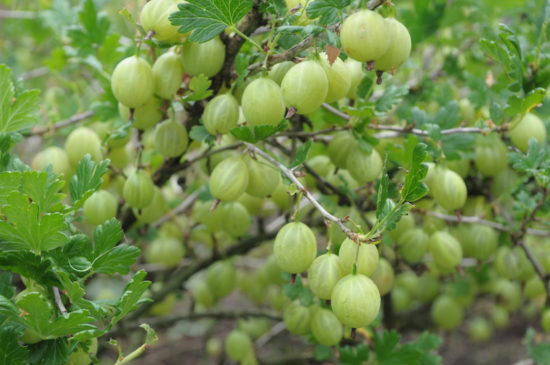
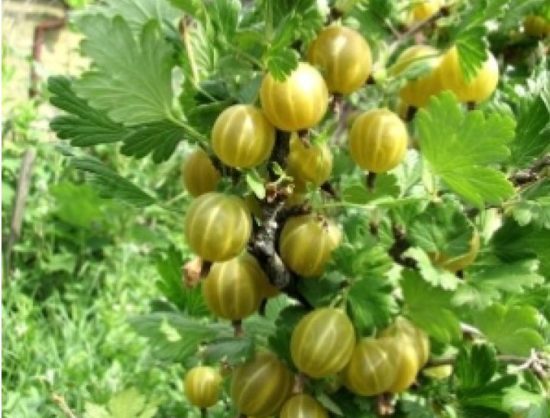
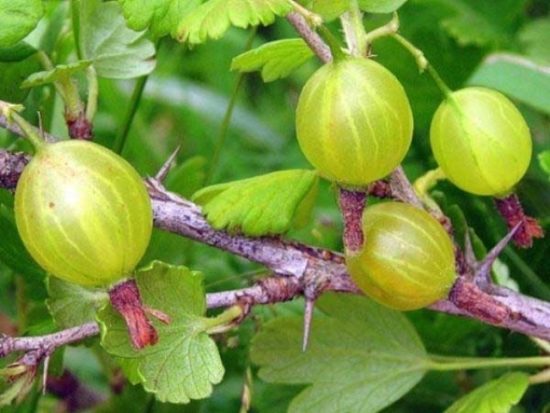

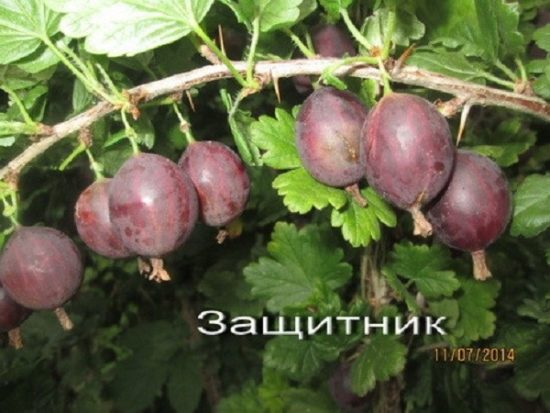
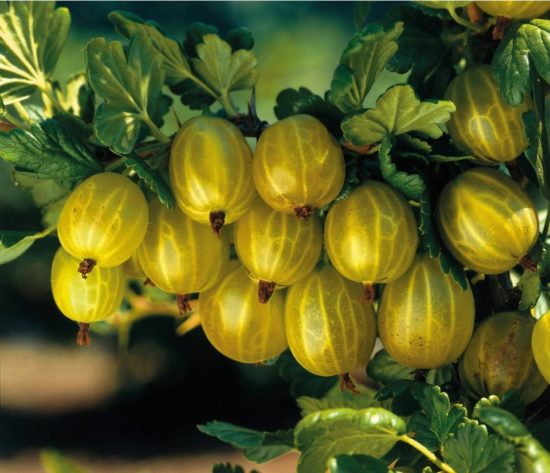
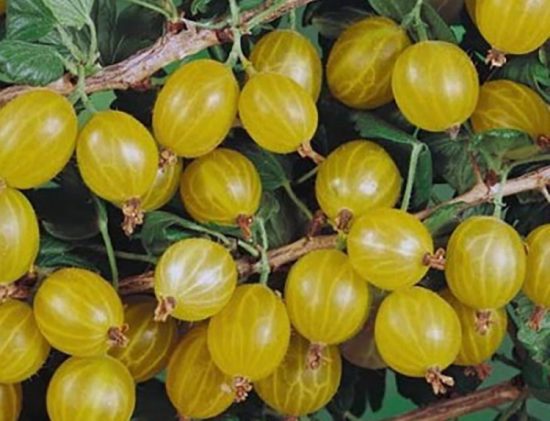
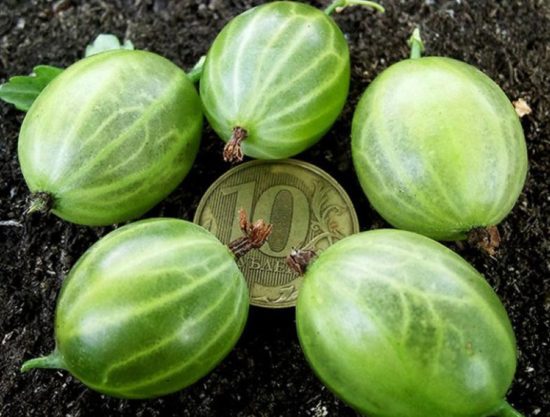
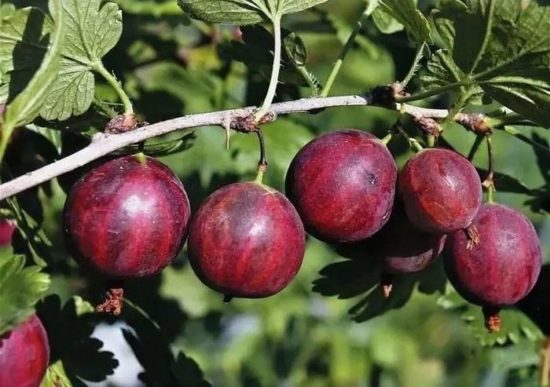
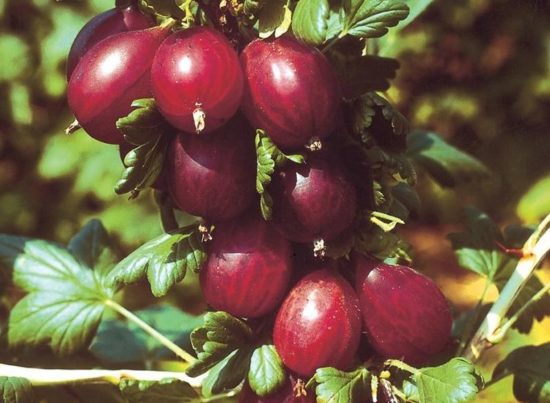
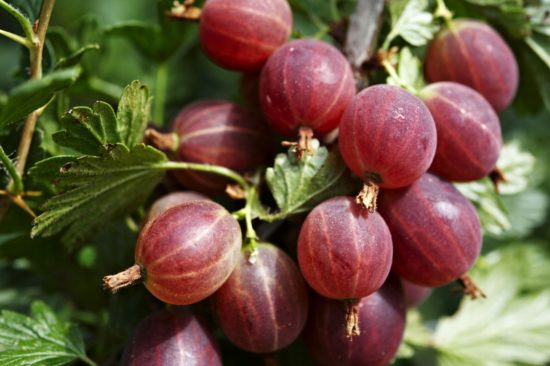
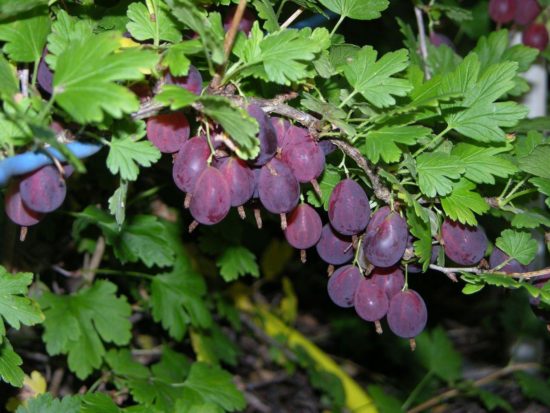
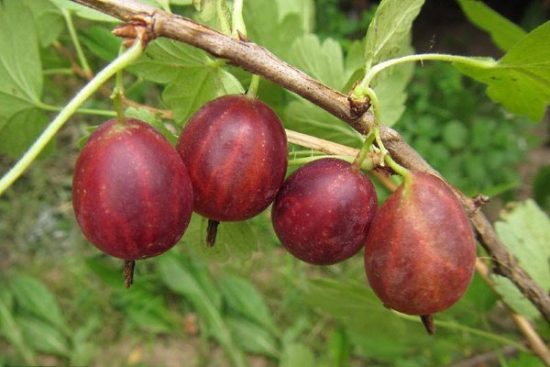
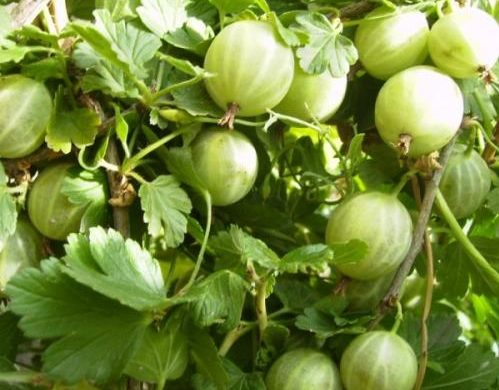
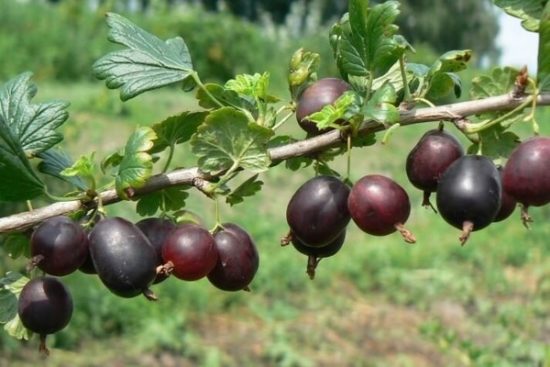

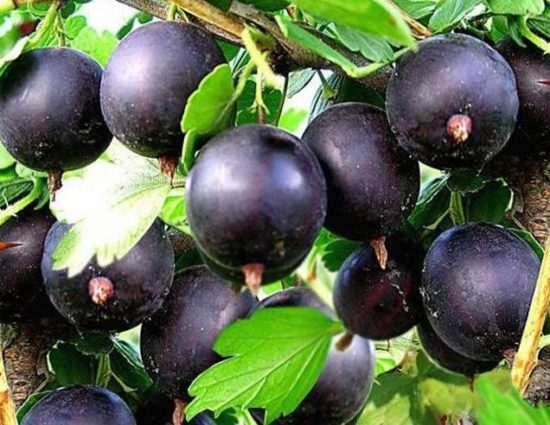

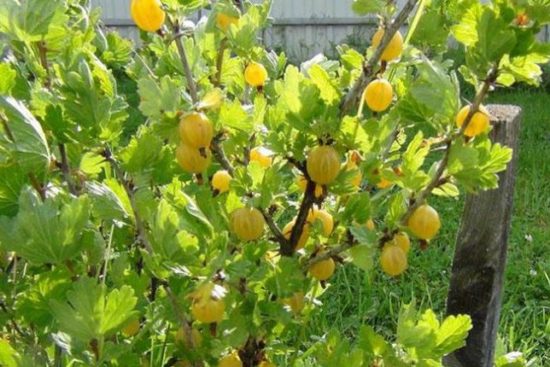
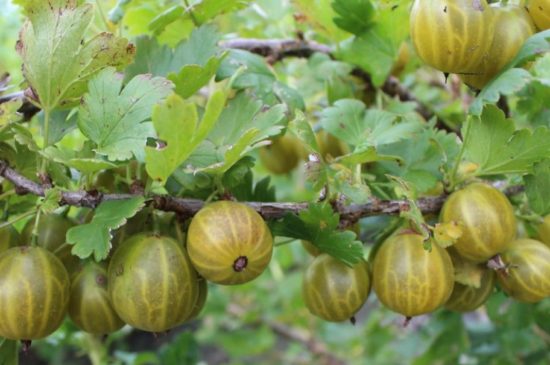
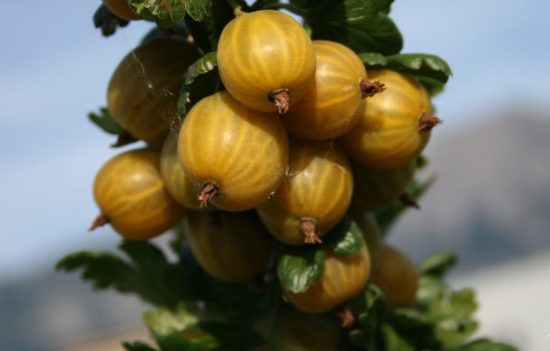
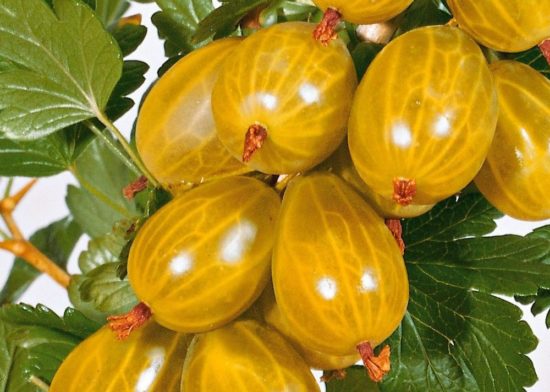
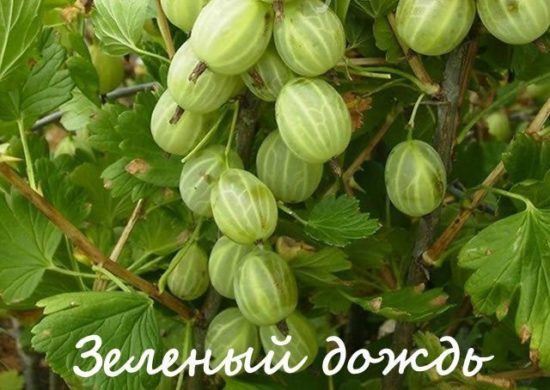
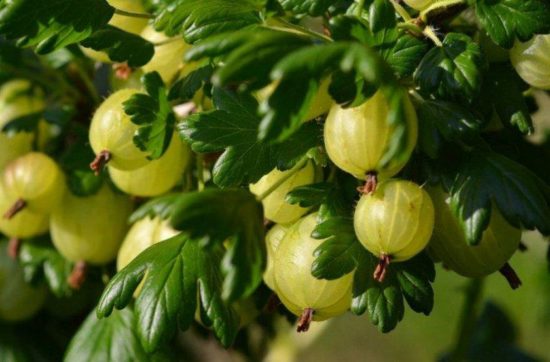
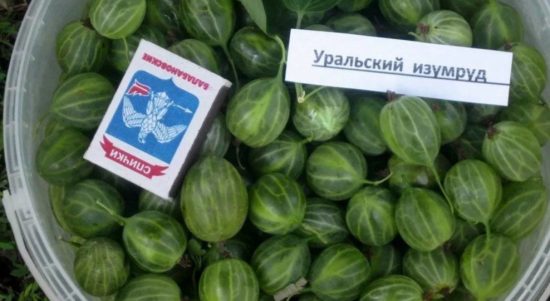


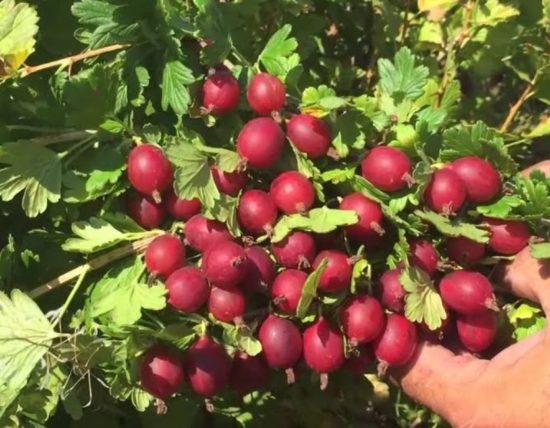
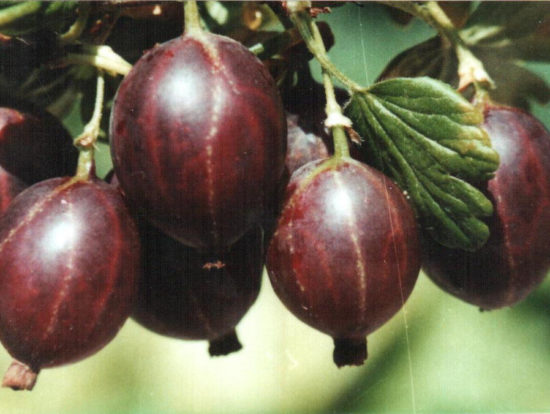
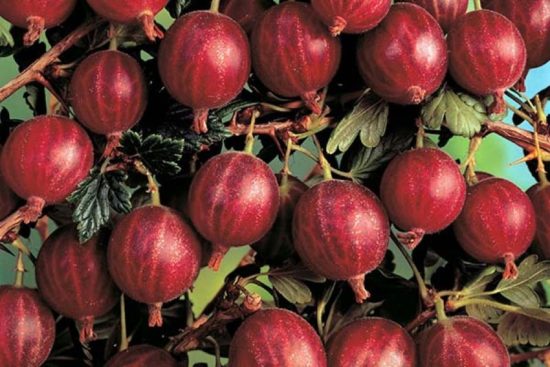
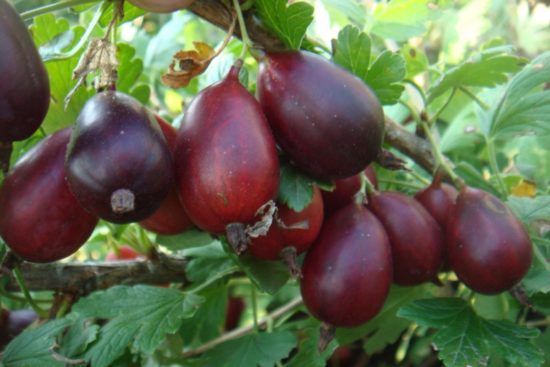

 (4 ratings, average: 4,00 out of 5)
(4 ratings, average: 4,00 out of 5) CUCUMBERS NEVER GET SICK, I'VE BEEN USING ONLY THIS FOR 40 YEARS! I SHARE A SECRET WITH YOU, CUCUMBERS ARE LIKE THE PICTURE!
CUCUMBERS NEVER GET SICK, I'VE BEEN USING ONLY THIS FOR 40 YEARS! I SHARE A SECRET WITH YOU, CUCUMBERS ARE LIKE THE PICTURE! You can dig a bucket of potatoes from each bush. Do you think these are fairy tales? Watch the video
You can dig a bucket of potatoes from each bush. Do you think these are fairy tales? Watch the video
 How our fellow gardeners work in Korea. There is a lot to learn and just fun to watch.
How our fellow gardeners work in Korea. There is a lot to learn and just fun to watch. Eye trainer. The author claims that with daily viewing, vision is restored. They don't charge money for views.
Eye trainer. The author claims that with daily viewing, vision is restored. They don't charge money for views. A 3-ingredient cake recipe in 30 minutes is better than Napoleon. Simple and very tasty.
A 3-ingredient cake recipe in 30 minutes is better than Napoleon. Simple and very tasty. Therapeutic exercises for cervical osteochondrosis. A complete set of exercises.
Therapeutic exercises for cervical osteochondrosis. A complete set of exercises. Which indoor plants match your zodiac sign?
Which indoor plants match your zodiac sign? What about them? Excursion to German dachas.
What about them? Excursion to German dachas.